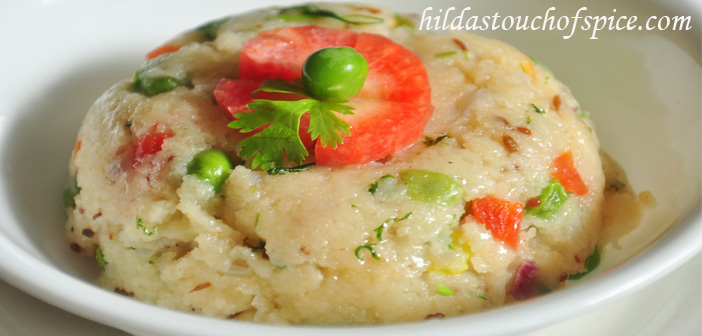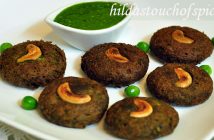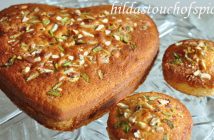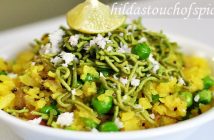Even though Upma is a traditional South Indian breakfast or tiffin, it is very popular throughout India. Most restaurants have it on their breakfast and snack menu. It is loved so much because it is tasty and filling. With a little pre-preparation, you can prepare it in a jiffy and relish it piping hot! It is super delicious, nutritious and very healthy. You can further enhance and increase its nutritive value with the addition of vegetables.
It is a good and smart idea to dry roast the semolina and store in an airtight container so that it is handy to use at short notice. This way the semolina will be preserved for a longer period. To preserve semolina without roasting you can refrigerate in an airtight packet or container. I make upma, sheera and halva ever so often so I dry roast a batch of semolina and manage to save time.
My hubby and I love upma. We can eat it at any time of the day. We never miss an opportunity to enjoy and relish it in restaurants. Pune is blessed with restaurants par excellence especially South Indian ones. Their quality is remarkable and their service is impeccable. We always enjoy all South Indian delicacies with South Indian filter coffee. Well, even at home we enjoySouth Indian snacks and breakfast with hot cups of chai (tea) or filter coffee.
I will always remember my South Indian friends in college and at work who shared their superb homemade tiffin especially Upma. Over the years I mastered my own technique of making upma, sheera, halva and other delicacies but Upma tops the list! Sometimes I temper the upma twice! First, I boil part of the tempering with water and then add the semolina.At the final stage, I add the reseredtempering before serving just like the way dal is tempered. It depends on one’s preference.I enjoy preparing upma and that’s why I take my sweet pace and make it memorable each time in the kitchen.
Today’s Vegetable Upma recipe is one of the ways I prepare it. We have always had our own Kadipatta (curry leaf) trees. I always use the fresh leaves whenever and just as much as I need so all my South Indian dishes are laced with a heavenly distinct aroma of curry leaves. Besides, I like to use homemade ghee or use; Amul, Chitale, etc which is really good quality ghee. I feel it enhances and brings out the best flavor in the finished dish.
Here is the recipe which is so fulfilling come rain or shine… I truly relish each time…every time… 🙂
Ingredients:
- 1 ½ cups Semolina/Rawa/Suji(dry roasted)
- 1 ½ med. Onions (peeled & finely chopped)
- 1 Green Chilli (finely chopped) or to taste
- 1 sprig Curry Leaf
- 1 tsp. Mustard Seeds
- ½ tsp. Cumin Seeds
- ½ tbsp. Urad Dal (split & skinless)
- ½ inch fresh Ginger (scraped & grated)
- ½ fresh Carrot (peeled & cubed)
- ¼ cup frozen Green Peas
- 1 tbsp. Sugar or to taste
- 3 tbsp. Vegetable Oil
- ½ tbsp. Pure Ghee/Homemade Ghee/clarified Butter
- 3 cups hot Water or as required
- Salt to taste
Suggested Garnishing:
- Fine Sev
- Freshly chopped Coriander Leaves
- Squeeze of Lime or quartered lime pieces
Procedure:
Keep hot water ready in a pot.
Heat a sufficiently deep, wide and thick bottomed non stick pan or pressure cooker body with oil until hot.
Reduce heat to low and splutter mustard seeds, cumin seeds, curry leaf.
Add urad dal and fry until lightly golden.
Add and sauté the onions until glossy and translucent.
Stir in and lightly sauté for a few seconds, green chilli, ginger, sugar and the vegetables.
Add the hot water, a tablespoon of chopped coriander, a little salt. Give it a stir; increase heat to medium and let the water come to a rolling boil.
Reduce heat and cook for about 2 minutes.
Now gradually stir in the roasted semolina in two or three batches making sure that there are no lumps. Keep stirring continuously.
The mixture will be bubbling so adjust heat accordingly.
If the mixture is too thick and dry, add a little hot water at a time so that the mixture cooks well.
Taste to check seasoning and add salt if necessary.
As the mixture cooks, the semolina will absorb water and start to thicken. The mixture should be a little soft and not too thick.
Now, it is time to stir in the ghee; if using (this is optional).
Stir the upmavigorously on medium high heat.
The upma will now start turning glossy and come together into a soft ball.
Even if it is a little extra soft and lightly loose it is fine. While cooling the semolina will absorb moisture and the upma will turn firm.
Temper the upma again. This is purely optional. I do this sometimes.
Serve immediately garnished with coriander leaves, sev and lime quarters.
You may serve chutney and pickles of your choice on the side if you so like.
Tips & Variations:
- The texture of the Upma depends on personal preference so you may use thick grain or fine grain semolina/suji/rawa.
- You can use fresh peas if you so prefer but it is better to blanch them before use to fasten the cooking process. I prefer frozen as it is handy at short notice.
- Soft or firm Upma is a matter of personal choice so you need to adjust water accordingly.
- Ghee enhances the flavor and imparts a lovely gloss to the finished Upma. Again it all depends on personal taste.
- Upma can be tempered after it is cooked or the tempering can be cooked in water like the way I have done or do it both ways! J It is again a matter of personal preference.
- To enhance the nutritive value you can add vegetables of your choice and a mix of split skinless chana dal and urad dal. I sometimes like to use moong dal too.




